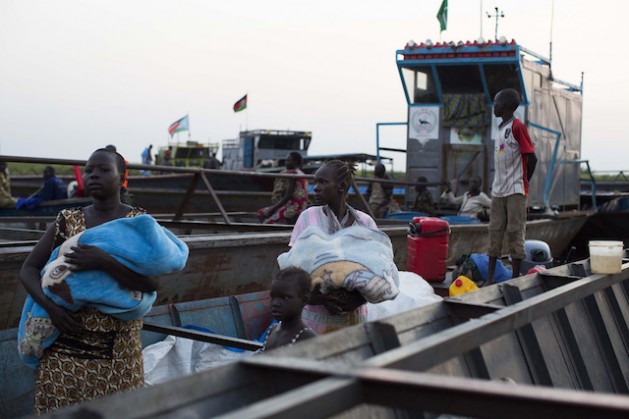by CHARLTON DOKI
 Displaced women flee fighting by boat to Mingkaman, Awerial County, Lakes State, South Sudan.. Only one out of 10 HIV positive mothers can get the drugs needed to avoid infecting her baby. PHOTO/ Mackenzie Knowles-Coursin/IPS
Displaced women flee fighting by boat to Mingkaman, Awerial County, Lakes State, South Sudan.. Only one out of 10 HIV positive mothers can get the drugs needed to avoid infecting her baby. PHOTO/ Mackenzie Knowles-Coursin/IPS
Dressed in a flowered African print kitenge and a blue head scarf, Sabur Samson, 27, sits pensively at the HIV centre at Maridi Civil Hospital in South Sudan’s Western Equatoria state.
Today she paid 20 South Sudanese pounds (about six dollars) for a bodaboda (motorbike taxi) ride to the centre and will have to skimp on food in the next days.
She will be hungry and few will help her in the village, although she is blind and a single mother of two children.
“Many people fear to come close because they fear they will contract HIV,” she told IPS.
Seated next to her, Khamis Mongo, 32, has lived with HIV for five years now and has suffered similar rejection. “Some people don’t want to eat from the same plate with me,” he says.
Mongo and Samson are among nearly 1,000 HIV positive people receiving care at the centre, of whom 250 are in antiretroviral therapy (ART). They are lucky: in South Sudan, just one out of 10 people needing ART gets it.
The clinic sees patients coming from as far as 100 kilometres.
“So many patients are dying because they can’t afford transport to collect their medicine here,” clinical officer Suzie Luka told IPS.
A one-way, 80 km bodaboda trip from Ibba to Maridi costs 150 South Sudanese pounds (47 dollars).
The challenges in Maridi are a microcosm of those that the world’s newest country, South Sudan, faces in containing the HIV epidemic.
Inter Press Service for more